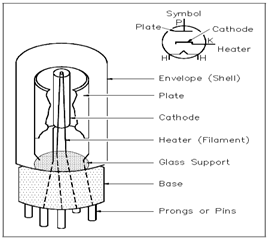Thermionic Emission:
A thermionic energy converter is a device that consists of two electrodes placed near one another in a vacuum. A single electrode is generally called the emitter, or, cathode and the other is known as the plate, or anode. Ordinarily, electrons in the cathode are avoided from escaping from the surface through a potential-energy barrier. Whenever an electron begins to move away from the surface, that will induces a corresponding positive charge in the material that tends to pull it back into the surface. For escape, the electron must somehow obtain enough energy to overcome this energy barrier. An ordinary temperature, almost none of the electrons can obtain enough energy to escape. Therefore, when the cathode is extremely hot, the electron energies are greatly increased through thermal motion. A substantial number of electrons are able to escape at sufficiently high temperatures. The liberation of electrons from a hot surface is known as thermionic emission.
The electrons which have escaped from the hot cathode form a cloud of negative charges near it is known as a space charge. The electrons in the cloud are attracted to it if the plate is maintained positive along with respect to the cathode via a battery. As long as the potential difference among the electrodes is maintained, there will be a steady current flow from the cathode to the plate.
The easiest instance of a thermionic device is a vacuum tube diode within that the only electrodes are the cathode and plate, or anode, as display in Figure. The diode could be used to convert AC (alternating current) flow to a pulsating direct current (DC) flow.

Figure: Vacuum Tube Diode